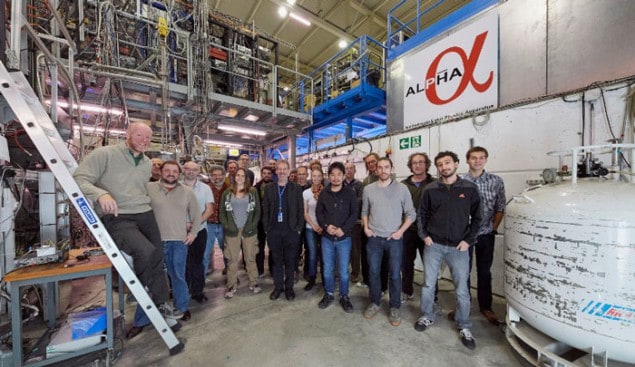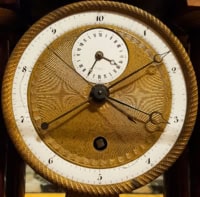
The first measurement of an atomic transition in an antiatom has been made by researchers working in the ALPHA collaboration at CERN in Geneva. The team measured the frequency of a specific transition in antihydrogen, which consists of a positron (an antielectron) bound to an antiproton. Although the result is no different from that measured in normal hydrogen, the group says that more sensitive versions of its experiment might one day reveal a new matter–antimatter asymmetry in nature.
The transition in question is between the 1s (ground) and 2s (excited) states of antihydrogen. This process could be sensitive to a violation of what is known as charge, parity and time reversal (CPT) symmetry. This states that the behaviour of any physical system remains unaltered under the combined reversal of charge, spatial coordinates and time. Although CPT symmetry has solid theoretical support, experimentalists are nevertheless keen to put it to the test. Its violation, for example, might explain why the universe today appears to consist almost entirely of matter – even though equal amounts of matter and antimatter were thought to have been produced during the Big Bang. “Other symmetries that were thought to be inviolable have been broken before,” notes ALPHA spokesperson, Jeffrey Hangst of Aarhus University in Denmark.
ALPHA, like a number of other antimatter experiments at CERN, takes its antiprotons from the lab’s Antiproton Decelerator, and then slows down and cools the particles before combining them with chilled positrons from a sodium-22 source. The resulting sub-kelvin atoms of antihydrogen are then trapped – thanks to their tiny magnetic dipole moments – in a potential well created by the careful overlap of several magnetic fields.
Antiatoms drop out
To carry out their spectroscopic measurements, Hangst and colleagues fire a laser beam into the magnetic trap and let it bounce numerous times between two mirrors. The laser’s frequency is tuned to roughly half that of the 1s to 2s transition in normal hydrogen. This is because the transition involves the absorption of two photons, and its precise frequency is determined to some extent by the presence of the trapping magnetism. Some of the antiatoms should then be excited and drop out of the trap as a result of one of two mechanisms – either by absorption of a third photon to become ionized, or by having their spin flipped. The researchers then repeat the process with the laser tuned to different frequencies, as well as with no laser at all.
Carrying out the whole procedure 11 times, the group found that on average just under 60% of antiatoms left the trap with the laser tuned to the 1s-2s transition, while no antiatoms (within the bounds of statistical error) dropped out when the laser was tuned to a different frequency or when it was switched off. The researchers say that the antiatoms underwent the transition at the expected frequency and therefore behaved no differently from normal hydrogen.
Although the result does nothing to threaten CPT symmetry, Hangst argues that it testifies to the enormous technical progress that has been made in the field of antiatom research – first in producing atoms of antihydrogen, then in cooling them, and then in trapping them. In particular, his group has recently made progress in two areas. They have trapped significant numbers of antiatoms at the same time – up from about one to around 14 within the past year. They have also created a resonant cavity around the magnetic trap in order to boost the intensity of the laser light to the point where it could interact with the very few antiatoms present.
Opening salvo
ALPHA’s achievement has earned praise from other antimatter groups at CERN. Ryugo Hayano of the University of Tokyo and spokesperson of the ASACUSA experiment, describes the research as “a very important milestone”, while AEgIS spokesperson Michael Doser says it constitutes the “opening salvo in precision spectroscopic measurements of antihydrogen”.
All, however, agree that it will not be easy boosting the precision achieved in the latest work by the roughly five orders of magnitude needed to match the sensitivity already obtained in spectroscopic measurements of ordinary hydrogen. Doser says there will be “many challenges” in doing this, including how to prepare antiatoms at millikelvin temperatures, in order that more of them can be trapped magnetically, and how to better reduce or disentangle the effect of the magnetic fields on the energy levels of the antiatoms. But he adds that ALPHA has been “quite effective at coming up with solutions” to all of the technical problems they have encountered to date.
Hangst says that the collaboration’s next step will be to plot the shape of the 1s-2s resonance when the Antiproton Decelerator switches on again next spring. So far he and his colleagues have just made measurements on one side of it.
Pain and delight
Indeed, Gerald Gabrielse of Harvard University in the US, who is spokesperson of the ATRAP experiment, says: “I look forward to the day when either ALPHA or ATRAP eventually traces out a complete 1s-2s resonance lineshape at a significant precision”. He adds that his group actually started working towards antihydrogen spectroscopy ten years earlier than did ATHENA (the predecessor to ALPHA), saying that his “parental delight” at the latest work is “only tempered by the pain that I feel in ATRAP not getting the first suggestive result”.
However, according to Walter Oelert of Mainz University in Germany, who led the team that produced the first antiatoms, the contest for higher precision remains very much on. “It is by no means clear which collaboration will reach the 10-15 target first,” he says, “although ALPHA can celebrate the first step.”
The research is reported in Nature.



